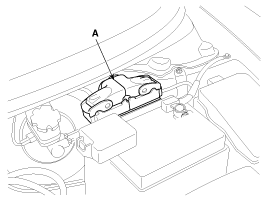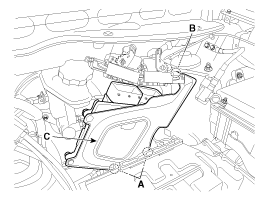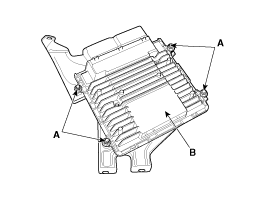 Kia Sportage: Engine Control Module (ECM): Repair procedures
Kia Sportage: Engine Control Module (ECM): Repair procedures
Third generation SL (2010ŌĆō2016) / Kia Sportage SL Service & Repair Manual / Engine Control / Fuel System / Engine Control System / Engine Control Module (ECM): Repair procedures
| Removal |
| 1. |
Turn ignition switch OFF and disconnect the negative (-) battery cable. |
| 2. |
Disconnect the ECM Connector (A).
|
| 3. |
Remove the battery (Refer to "Intake And Exhaust System" in EM group). |
| 4. |
Remove the mounting bolts (A) and nut (B), and then remove the ECM assembly (C).
|
| 5. |
Remove the installation nuts (A), and then remove the ECM (B) from the bracket.
|
| Installation |
| 1. |
Installation is reverse of removal.
|
| ECM Problem Inspection Procedure |
| 1. |
TEST ECM GROUND CIRCUIT: Measure resistance between ECM and
chassis ground using the backside of ECM harness connector as ECM side
check point. If the problem is found, repair it.
|
| 2. |
TEST ECM CONNECTOR: Disconnect the ECM connector and visually
check the ground terminals on ECM side and harness side for bent pins
or poor contact pressure. If the problem is found, repair it. |
| 3. |
If problem is not found in Step 1 and 2, the ECM could be
faulty. If so, make sure there were no DTC''s before swapping the ECM
with a new one, and then check the vehicle again. If DTC''s were found,
examine this first before swapping ECM. |
| 4. |
RE-TEST THE ORIGINAL ECM: Install the original ECM (may be
broken) into a known-good vehicle and check the vehicle. If the problem
occurs again, replace the original ECM with a new one. If problem does
not occur, this is intermittent problem (Refer to ŌĆ£Intermittent
Problem Inspection ProcedureŌĆØ in Basic Inspection Procedure).
|
| Adjustment |
| ŌĆó |
After replacing the ECM of the vehicle with the immobilizer, the following procedure must be performed. |
|
[If installing a used ECM] |
| 1) |
Perform "ECM Neutral Mode" procedure using GDS. (Refer to "Body Electrical System - "Immobilizer System - Repair procedures") |
| 2) |
After finishing "ECM Neutral Mode", perform "Key Teaching"
procedure using GDS. (Refer to "Body Electrical System - "Immobilizer
System - Repair procedures") |
|
[If installing a new ECM]
Perform "Key Teaching" procedure using GDS. (Refer to "Body Electrical System - "Immobilizer System - Repair procedures") |
| ŌĆó |
After replacing the ECM of the vehicle with the smart key system (button start), the following procedure must be performed. |
|
[If installing a used ECM] |
| 1) |
Perform "ECM Neutral Mode" procedure using GDS. (Refer to "Body Electrical System - "Smart key System - Repair procedures") |
| 2) |
After finishing "ECM Neutral Mode", turn IGN ON then OFF
using the smart key or start button. Then the ECM learns information on
the smart key automatically. |
|
[If installing a new ECM]
Turn IGN ON then OFF using the smart key or start button. Then the ECM learns information on the smart key automatically. |
| ŌĆó |
After replacing ETC module or ECM, the ETC adaptive value must be reset / relearned.
(Refer to "Engine Control System - ETC - adjustment") |
 Engine Control Module (ECM): Schematic Diagrams
Engine Control Module (ECM): Schematic Diagrams
ECM Terminal And Input/Output signal
ECM Terminal Function
Connector [CHTG-AG]
PinNo.DescriptionConnected to1Ignition Coil (Cylinder #2) control output [Without Smart Key]Ignition Coil (Cylin ...
 ETC (Electronic Throttle Control) System: Description and Operation
ETC (Electronic Throttle Control) System: Description and Operation
Description
The Electronic Throttle Control (ETC) System consists of a
throttle body with an integrated control motor and throttle position
sensor (TPS). Instead of the traditional throttle cab ...
Other Information:
Description and Operation
Description
The starting system includes the battery, starter, solenoid
switch, ignition switch, inhibitor switch (A/T), clutch pedal switch
(M/T), ignition lock switch, connection wires and th ...
High beam operation
To turn on the high beam headlights, push the lever away from you. Pull it back
for low beams.
The high beam indicator will light when the headlight high beams are switched
on.
To prevent the ...
Categories
- Home
- Kia Sportage QL (2015-2019) Owners Manual
- Kia Sportage QL (2015-2019) Service Manual
- Kia Sportage SL 2010-2016 Owners Manual
- Kia Sportage SL 2010-2016 Service Manual
Copyright ® www.kispmanual.com 2014-2026



